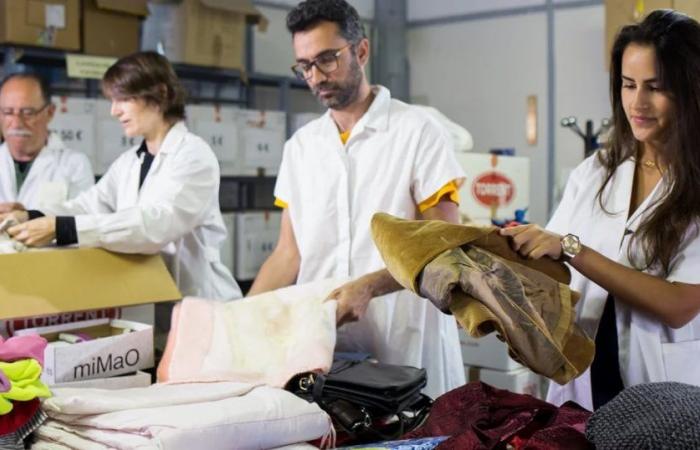Romina is a Nursing Auxiliary Care Technician (TCAE), but in her free time she dedicates herself to crafts. Although he started doing scrapbooking -craft technique that consists of creating and decorating personalized scrapbooks-, its hobby has evolved to finish restoring furniture that you find in municipal recycling centers. “The first time I did it gave me shamebut now even the workers at the clean point in my town know me,” he says. Infobae Spain.
Romina does not sell this furniture, but rather keeps it in her house or gives it to her parents, siblings and nephews, although she knows that I could get a lot of money for them: “In the end, unique furniture is made that no one else has. I know people who sell them for 250 and even 500 euros, depending on the piece. For something they have found in the trash! Although it is also nice to know that they occupied a place in another house, with another family, and that now it belongs to you.” This new fashion is called stooping and consists of rescue furniture of garbage containers, restore them and sell them online. It is one of the most popular activities in the second hand trade currently, but not the only one.
The purchase and sale of reused products It has ceased to be a trend and has become a reality of mass consumption. 94% of Spaniards Consider choosing reused products for any purchasing occasion. This is what the report states The Network of Change produced by Wallapop together with 40db to know the perception of Spaniards regarding conscious consumption models and the circular economy. The adoption of second-hand is evident in both the purchase and sale of reused products. At the moment, 8 out of 10 Spaniards He claims to review the products he has at home to sell at least once a year.
And, although second-hand trading has always been linked to the poorest social classes, currently It has nothing to do with economic status. to which one belongs. “Traditionally, we tended to identify the sale and purchase of used products with the most vulnerable economies, such as households that had more difficulties to make ends meet. And now we find that there are no significant differences between the type of home economy. Another thing is that the reason is the same, but entering to buy and sell in this market of reused products is something that is transversal to all social classes”explains sociologist and CEO of 40db, Belén Barreiro.
Therefore, in recent years there has been a growing popularity of second hand clothing storesfrequented by numerous influencers and ‘modern’ -those, generally from large cities, who dress in unique and creative styles to differentiate themselves from the rest- in their Youtube videos looking for clothes vintage. Bookstores that prioritize old works over new editions are also successful. There are even numerous video game, manga or furniture establishments that, in addition to selling their new products, also offer them. reused at a lower price.
According to Wallapop’s sustainability manager, Pol Fábrega, success lies in the overcoming prejudices: “In recent years, we have managed to eliminate the barriers and prejudices associated with the purchase and sale of reused products, to the point that it has become a generalized option among the population in Spain, as well as an alternative to sell household objects and give them a second life, guaranteeing the durability of the offer that makes more circular consumption possible.”
In a socioeconomic context characterized by inflation, 94% of people consider the price as a decisive factor in all your consumer decisions. However, in the repurposed market, these decisions are often influenced by other emotional motivations. As the study specifies, 47% of consumers opt for reused products with the intention of making a more responsible consumptionfind original items or purchase discontinued and special products that They have their own story. Regarding sales, 56% are guided by sustainability reasonssuch as avoiding hoarding, encouraging reuse or helping others.
In this sense, the most important thing is to promote the circular economy, a production and consumption model that focuses on reusing, repairing, renewing and recycling existing materials and products to prolong its useful life. This approach minimizes waste generation, reduces consumption of raw materials, water and energy, and reduces environmental impact. In contrast to the linear economy of “produce, use and dispose”the circular economy fosters a more sustainable society, reducing dependence on non-renewable resources and minimizing damage to the environment.
Another factor that has contributed to the popularity of second-hand sales is the originality of old products (often renewed) and the fact that each one has its own story, as Romina pointed out. Today it is quite common for people to spend money on “grandmother’s furniture” with a touch of “body and paint”, even if that means paying a higher price; or with the vinyl records that 40 years ago people threw away – due to the arrival of CDs – and that now young people are determined to recover a much higher price than what they were worth at the time. And the peculiar and exclusive (even if it was previously the most common) sells a lot.
The report also seeks to anticipate consumption trends for reused products in the near future. Looking ahead to 2030, 92% of people are expected to reflect more on whether they really need a product before purchasing itand 89% will choose to sell those items they no longer need so that others can use them, instead of storing them. Furthermore, within five years, it is expected that 9 out of 10 people will buy at least as many reconditioned products as new, and even more, and that only 8% of the population in Spain has never purchased this type of item.
For Barreiro, this boom in second-hand sales “coincides very well with the rising values in this current society, which have to do with the fact that we want to live in a community in which we get rid of what is left over. We want to go authentic, live lightly, live with less. And I believe that this is one of the trends that we see in the study that is also behind the success of the purchase and sale of reused products. “That fits with a philosophy of life that is growing.”






